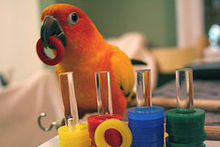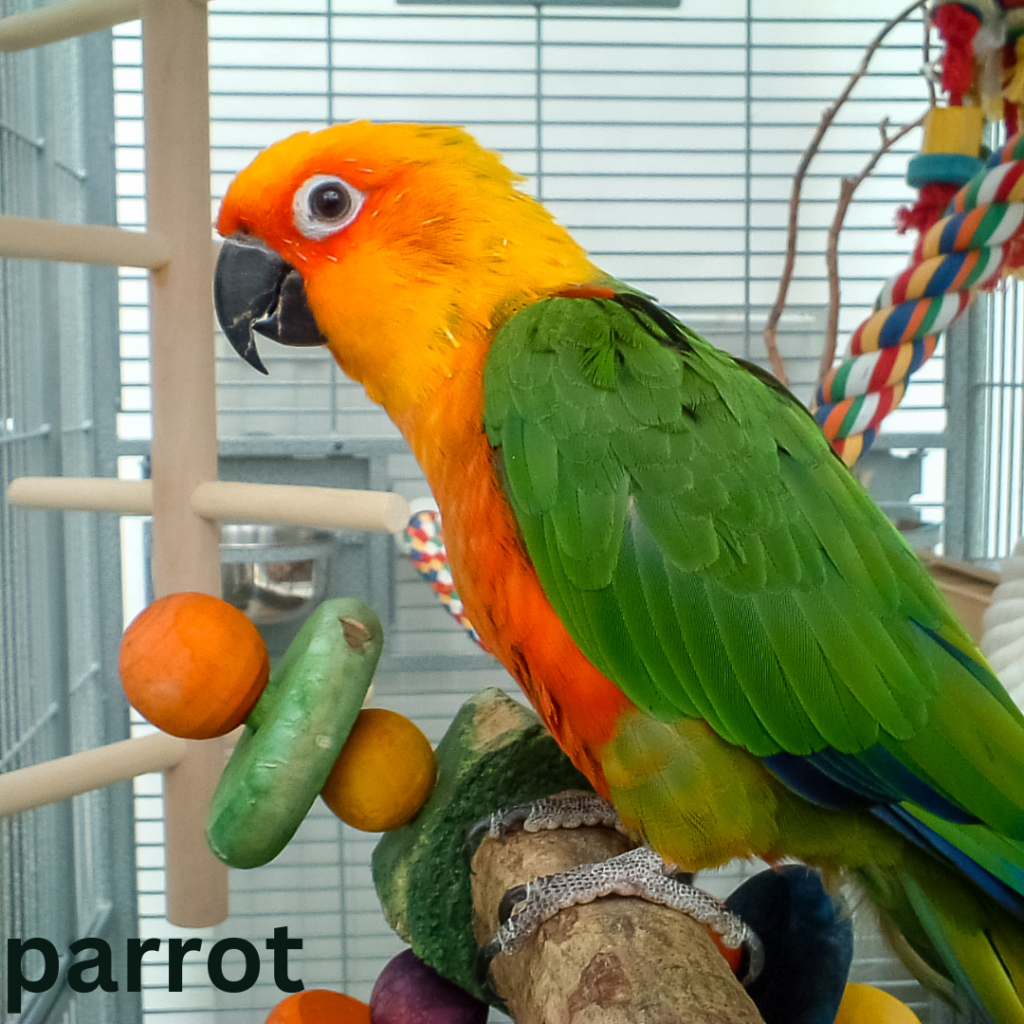Parrots are birds of the order Psittaciformes.[1][2][3] There are about 372 species in 86 genera. They are found in most tropical and subtropical regions. The greatest diversity of parrots is found in South America and Australasia.
Parrots are intelligent birds. They have relatively large brains,[4] they can learn, and they can use simple tools.[5] Because some species have the ability to make sounds like human voices and have plumages with bright colors, many species are kept as pets. This includes some endangered and protected species.
Description[change | change source]
Parrots have a compact body with a large head and a short neck. Their beaks are short, strong and curved. The two parts of the beak are very strong and used to break fruits and seeds. The tongue is large and strong. Most parrots can fly, though some lost their powers of flight after they came to live on oceanic islands. The kakapo is an example.
Parrots have strong legs, and clawed zygodactyl feet (with two toes facing forward and two toes facing back) that are very useful to climb up trees. Many parrots are vividly coloured, and some are multi-coloured. The plumage of cockatoos ranges from mostly white to mostly black, with a mobile crest of feathers on the tops of their heads. Most parrots exhibit little or no sexual dimorphism.
Parrots are variably-sized. The smallest parrot is the pigmy parrot (Micropsitta pusio) with an adult weight of 11.5 grams (0.41 oz) and a length of 8.6 centimetres (3.4 in).[6] The hyacinth macaw (Anodorhynchus hyacinthinus) is longer than any other species of parrot, although half its length is tail.[7]
Behavior[change | change source]

Parrots eat seeds, nuts, buds and other plant material. A few species sometimes eat animals and carrion (dead animal carcasses), while the lories and lorikeets are specialised for feeding on floral nectar and soft fruits. Almost all parrots nest in tree hollows, and lay white eggs from which hatch altricial (helpless) young.
Parrots are among the most intelligent birds. The ability of some parrots to make sounds like human voices makes them popular as pets.
Conservation[change | change source]
The capture of wild parrots for the pet trade, as well as hunting, habitat loss and competition from invasive species, has diminished wild populations, with parrots being subjected to more exploitation than any other group of birds.[8] Measures taken to conserve the habitats of some high-profile species have also protected many of the less charismatic species living in the same ecosystems.[9]
Some parrots can live up to 80 years. Many parrots can imitate human speech; they can speak simple words if repeated a few times.
Origins and evolution[change | change source]
Transposons in the genomes of passerines and parrots are similar, but those in the genomes of other birds are not. This is strong evidence that parrots are the sister group of passerines.[10]
Europe is the origin of the first presumed parrot fossils, which date from about 50 million years ago (mya).[11] The climate there and then was tropical. Several fairly complete skeletons of parrot-like birds have been found in England and Germany.[12] On the whole it seems likely that these are not direct ancestors of the modern parrots, but related lineages which evolved in the northern hemisphere, and which have since died out.
The earliest records of modern parrots date to about 23–20 mya and are also from Europe. Subsequently, the fossil record—again mainly from Europe—consists of bones clearly recognisable as belonging to parrots of modern type. The southern hemisphere does not have nearly as rich a fossil record for this period as the northern, and contains no known parrot-like remains earlier than the early to middle Miocene, around 20 mya. The first unambiguous parrot fossil (as opposed to a parrot-like one) is found in the Miocene. It is an upper jaw, identical that of modern cockatoos.
Related pages[change | change source]
References[change | change source]
- ↑ “Psittacine”. American Heritage Dictionary of the English Language. 4th ed. Houghton Mifflin Company. 2000. Archived from the original on 2007-08-27. Retrieved 2007-09-09.
- ↑ “Psittacine”. Merriam-Webster Online Dictionary. Merriam-Webster. Retrieved 25 June 2013.
- ↑ “Zoological Nomenclature Resource: Psittaciformes (Version 9.013)”. http://www.zoonomen.net. 2008-12-29.
- ↑ Iwaniuk, Andrew 2004. “This bird is no airhead”. Natural Sciences and Engineering Research Council of Canada. Archived from the original on 2008-02-22. Retrieved 2007-09-09.
- ↑ Beynon, Mike 2000. “Who’s a clever bird, then?”. BBC News. Archived from the original on 2007-09-01. Retrieved 2007-09-09.
- ↑ Forshaw, Joseph M.; Cooper, William T. (1981) [1973, 1978]. Parrots of the World (corrected second ed.). David & Charles, Newton Abbot, London. p. 149. ISBN 0-7153-7698-5.
- ↑ E. Hagan (2004). “Anodorhynchus hyacinthinus – hyacinth macaw”. Animal Diversity Web. Retrieved 26 June 2013.
- ↑ Snyder N et al 2000. Parrots: status survey and conservation action plan, 2000-2004. Chapter 1. vii. IUCN ISBN 2-8317-0504-5. Chapter 1. vii.
- ↑ Snyder N. et al 2000. Parrots: status survey and conservation action plan, 2000-2004. Chapter 1. vii. IUCN ISBN 2-8317-0504-5. Chapter 2. page 12.
- ↑ Suh A, Paus M, Kiefmann M; et al. (2011). “Mesozoic retroposons reveal parrots as the closest living relatives of passerine birds”. Nature Communications. 2 (8): 443–8. Bibcode:2011NatCo…2..443S. doi:10.1038/ncomms1448. PMC 3265382. PMID 21863010.
- ↑ Waterhouse, David M. (2006). “Parrots in a nutshell: The fossil record of Psittaciformes (Aves)”. Historical Biology. 18 (2): 223–234. doi:10.1080/08912960600641224. S2CID 83664072.
- ↑ Dyke, GJ; Cooper, JH (2000). “A new psittaciform bird from the London clay (Lower Eocene) of England”. Palaeontology. 43 (2): 271–285. doi:10.1111/1475-4983.00126. S2CID 84812434.
Other websites[change | change source]

Wikimedia Commons has media related to Psittaciformes.

Wikispecies has information on: Psittaciformes.
- “Parrots (Psittacidae)”. Internet Bird Collection. Archived from the original on 20 June 2016. Retrieved 25 June 2013.
- Animal Diversity Web – Psittaciformes – parrots
- ITIS Report – Psittaciformes
- Tree of Life – Psittaciformes
- World Birds Taxonomic List – Psittaciformes
Template documentation[view] [edit] [history] [purge]This template includes collapsible lists.• To set it to display all lists when it appears (i.e. all lists expanded), use: {{Anime and manga |expanded=all}} or, if enabled, {{Anime and manga |all}} (i.e. omitting “expanded=“).• To set it to display one particular list while keeping the remainder collapsed (i.e. hidden apart from their headings), use: {{Anime and manga |expanded=listname}} or, if enabled, {{Anime and manga |listname}}…where listname is one of the following (do not include any quotemarks):anime, manga, groups, genres, biographies, fandom, generalFor example, {{Anime and manga |expanded=anime}} or, if enabled, {{Anime and manga |anime}}The above documentation is transcluded from Template:Anime and manga/doc. (edit | history)Editors can experiment in this template’s sandbox (create | mirror) and testcases (create) pages. Add categories to the /doc subpage. Subpages of this template. |

Leave a comment